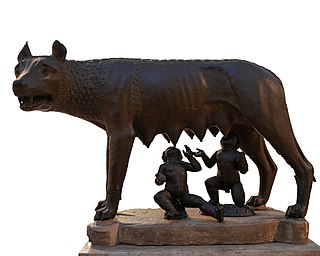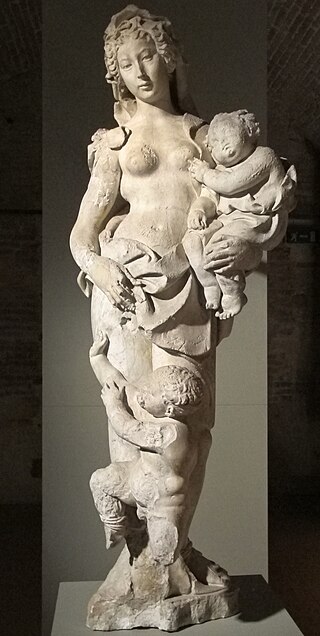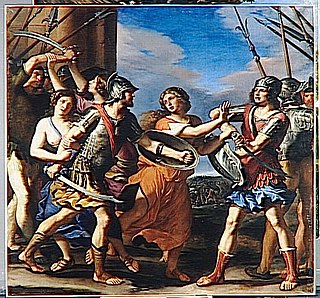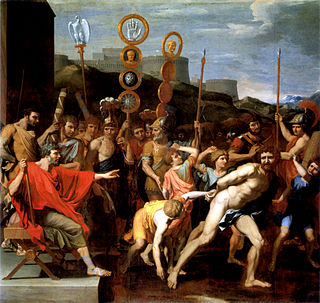
In Roman mythology, Romulus and Remus are twin brothers whose story tells of the events that led to the founding of the city of Rome and the Roman Kingdom by Romulus, following his fratricide of Remus. The image of a she-wolf suckling the twins in their infancy has been a symbol of the city of Rome and the ancient Romans since at least the 3rd century BC. Although the tale takes place before the founding of Rome around 750 BC, the earliest known written account of the myth is from the late 3rd century BC. Possible historical bases for the story, and interpretations of its local variants, are subjects of ongoing debate.

Acca Larentia or Acca Larentina was a mythical woman, later a goddess of fertility, in Roman mythology whose festival, the Larentalia, was celebrated on December 23.

In Roman mythology, Faustulus was the shepherd who found the infant Romulus and his twin brother Remus along the banks of the Tiber River as they were being suckled by the she-wolf, Lupa. According to legend, Faustulus carried the babies back to his sheepfold for his wife Acca Larentia to nurse them. Faustulus and Acca Larentia then raised the boys as their own. Romulus later defeated and killed King Amulius of Alba Longa, with the help of Faustulus, and his brother Pleistinus. Romulus and Remus set out to build their own city, but then had a falling out. In the ensuing skirmish, Faustulus and Pleistinus were killed. Romulus went on to found Rome

In Roman mythology, Amulius was king of Alba Longa who ordered the death of his infant, twin grandnephews Romulus, the eventual founder and king of Rome, and Remus. He was deposed and killed by them after they survived and grew to adulthood.

Louis Alexandre de Bourbon, a legitimated prince of the blood royal, was the son of Louis XIV and of his mistress Françoise-Athénaïs, marquise de Montespan. At the age of five, he became grand admiral of France.

Robert de Cotte was a French architect-administrator, under whose design control of the royal buildings of France from 1699, the earliest notes presaging the Rococo style were introduced. First a pupil of Jules Hardouin-Mansart, he later became his brother-in-law and his collaborator. After Hardouin-Mansart's death, de Cotte completed his unfinished projects, notably the royal chapel at Versailles and the Grand Trianon.

Romulus was the legendary founder and first king of Rome. Various traditions attribute the establishment of many of Rome's oldest legal, political, religious, and social institutions to Romulus and his contemporaries. Although many of these traditions incorporate elements of folklore, and it is not clear to what extent a historical figure underlies the mythical Romulus, the events and institutions ascribed to him were central to the myths surrounding Rome's origins and cultural traditions.

The Hôtel de Toulouse, former Hôtel de La Vrillière is located at 1 rue de La Vrillière, in the 1st arrondissement of Paris. Originally, the mansion had a large garden with a formal parterre to the southwest.

Louise Élisabeth de Bourbon was a daughter of Louis III de Bourbon, Prince of Condé, and his wife, Louise Françoise de Bourbon, légitimée de France, a legitimised daughter of King Louis XIV of France and his famous mistress, Madame de Montespan.

The Hôtel de Brienne is an 18th-century French hôtel particulier at 14 Rue Saint-Dominique in the 7th arrondissement of Paris. It serves as the official residence of the minister of defense.

Anselm Franz, 2nd Prince of Thurn and Taxis, was the second Prince of Thurn and Taxis, Postmaster General of the Imperial Reichspost, and Head of the House of Thurn and Taxis from 21 February 1714 until his death on 8 November 1739.

The hôtel de Villeroy, also the hôtel de Villeroy Bourbon or hôtel de la Poste, is a hôtel particulier, a type of large townhouse of France, at 34 rue des Bourdonnais, 9 rue des Déchargeurs, 17 rue des Halles in the 1st arrondissement of Paris. It is a designated monument historique.

The Statue of the Tiber river with Romulus and Remus is a large statue from ancient Rome exhibited at the Louvre museum in Paris, France. It is an allegory of the Tiber river that waters the city of Rome.

The Abduction of Helen is a 1628-1629 oil on canvas painting by Guido Reni, now in the Louvre Museum in Paris.

Hersilia Separating Romulus and Tatius or The Battle Between the Romans and the Sabines is a 1645 oil on canvas painting by Guercino, seized by the state during the French Revolution in 1794 and placed in the Louvre, where it still hangs. It shows Hersilia breaking up a battle between her husband Romulus and her Sabine brother Titus Tatius, with two other unnamed women doing similar in the background.

Cato of Utica Bidding Farewell to his Son is a 1635 oil on canvas painting, housed at the Musée des Beaux-Arts de Marseille since 1872.

Camillus Handing the Falerian Schoolmaster over to his Pupils is a 1637 oil on canvas painting by Nicolas Poussin, in the Louvre since its seizure for the state in 1794. It shows a scene from the capture of Falerii in Chapter 10 of Camillus, one of the Parallel Lives by Plutarch, in which Marcus Furius Camillus punishes a Falerian schoolmaster who hoped to gain favour by handing over his pupils to the Romans besieging the city.

Caesar Restoring Cleopatra to the Throne of Egypt' is an oil on canvas painting by Pietro da Cortona, one of three works by this artist and six works by others commissioned by Louis Phélypeaux, Seigneur of La Vrillière for the gilded gallery at his new hôtel de La Vrillière in Paris - he requested that the nine works be in similar style and dimensions to Guido Reni's The Abduction of Helen (Louvre), the first painting he ever acquired. It is usually dated to 1637. It has been in the musée des Beaux-Arts de Lyon since 1811.

The Emperor Augustus Closes the Doors of the Temple of Janus or The Peace of Augustus is a c.1655-1657 oil on canvas painting by Carlo Maratta, one of nine works commissioned by Louis Phélypeaux, Seigneur of La Vrillière for the gilded gallery at his new hôtel de La Vrillière in Paris. It is now in the Palais des Beaux-Arts de Lille.



















